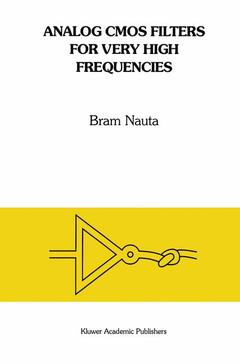Analog CMOS Filters for Very High Frequencies, 1993 The Springer International Series in Engineering and Computer Science Series, Vol. 190
Langue : Anglais
Auteur : Nauta Bram

Integrated circuit technology is widely used for the full integration of electronic systems. In general, these systems are realized using digital techniques implemented in CMOS technology. The low power dissipation, high packing density, high noise immunity, ease of design and the relative ease of scaling are the driving forces of CMOS technology for digital applications. Parts of these systems cannot be implemented in the digital domain and will remain analog. In order to achieve complete system integration these analog functions are preferably integrated in the same CMOS technology. An important class of analog circuits that need to be integrated in CMOS are analog filters.
This book deals with very high frequency (VHF) filters, which are filters with cut-off frequencies ranging from the low megahertz range to several hundreds of megahertz. Until recently the maximal cut-off frequencies of CMOS filters were limited to the low megahertz range. By applying the techniques presented in this book the limit could be pushed into the true VHF domain, and integrated VHF filters become feasible. Application of these VHF filters can be found in the field of communication, instrumentation and control systems. For example, pre and post filtering for high-speed AD and DA converters, signal reconstruction, signal decoding, etc. The general design philosophy used in this book is to allow only the absolute minimum of signal carrying nodes throughout the whole filter.
This strategy starts at the filter synthesis level and is extended to the level of electronic circuitry. The result is a filter realization in which all capacitators (including parasitics) have a desired function. The advantage of this technique is that high frequency parasitic effects (parasitic poles/zeros) are minimally present.
The book is a reference for engineers in research or development, and is suitable for use as a text for advanced courses on the subject.>
This book deals with very high frequency (VHF) filters, which are filters with cut-off frequencies ranging from the low megahertz range to several hundreds of megahertz. Until recently the maximal cut-off frequencies of CMOS filters were limited to the low megahertz range. By applying the techniques presented in this book the limit could be pushed into the true VHF domain, and integrated VHF filters become feasible. Application of these VHF filters can be found in the field of communication, instrumentation and control systems. For example, pre and post filtering for high-speed AD and DA converters, signal reconstruction, signal decoding, etc. The general design philosophy used in this book is to allow only the absolute minimum of signal carrying nodes throughout the whole filter.
This strategy starts at the filter synthesis level and is extended to the level of electronic circuitry. The result is a filter realization in which all capacitators (including parasitics) have a desired function. The advantage of this technique is that high frequency parasitic effects (parasitic poles/zeros) are minimally present.
The book is a reference for engineers in research or development, and is suitable for use as a text for advanced courses on the subject.>
1 Introduction.- 1.1 Introduction.- 1.2 Active monolithic filters, an overview.- 1.3 Monolithic analog continuous-time filters.- 1.4 Research topics.- 2 Filter Synthesis for (Very) High Frequencies.- 2.1 Introduction.- 2.2 Restrictions for very high frequencies.- 2.3 Synthesis methods.- 2.4 Sensitivity.- 2.5 Frequency and impedance level scaling.- 2.6 Conclusions.- 3 Effect of Non-Idealities.- 3.1 Introduction.- 3.2 Effect of finite integrator quality factor.- 3.3 Dynamic range.- 3.4 Dissipation and chip area.- 3.5 Capacitors.- 3.6 Conclusions.- 4 Transconductor Design.- 4.1 The MOS Transistor.- 4.2 Linear MOS transconductors, an overview.- 4.3 Design strategy for VHF transconductor.- 4.4 VHF transconductor, basic operation.- 4.5 Detailed analysis and measurements.- 4.6 Conclusions.- 5 Tuning.- 5.1 Introduction.- 5.2 The VCO tuning loop.- 5.3 Quality factor tuning.- 5.4 Supply voltage unit.- 5.5 Conclusions.- 6 Filter Realizations.- 6.1 Introduction.- 6.2 Third-order elliptic filters.- 6.3 TV IF Filter.- 7 Conclusions.- 7.1 Introduction.- 7.2 Summary.- 7.3 Original contributions to the thesis.- 7.4 Recommendations for further research.- References.
Date de parution : 10-2012
Ouvrage de 230 p.
15.5x23.5 cm
Thème d’Analog CMOS Filters for Very High Frequencies :
Mots-clés :
CMOS; Hochfrequenz; Signal; analog; communication; construction; development; electronic circuit; filter; integrated circuit
© 2024 LAVOISIER S.A.S.
